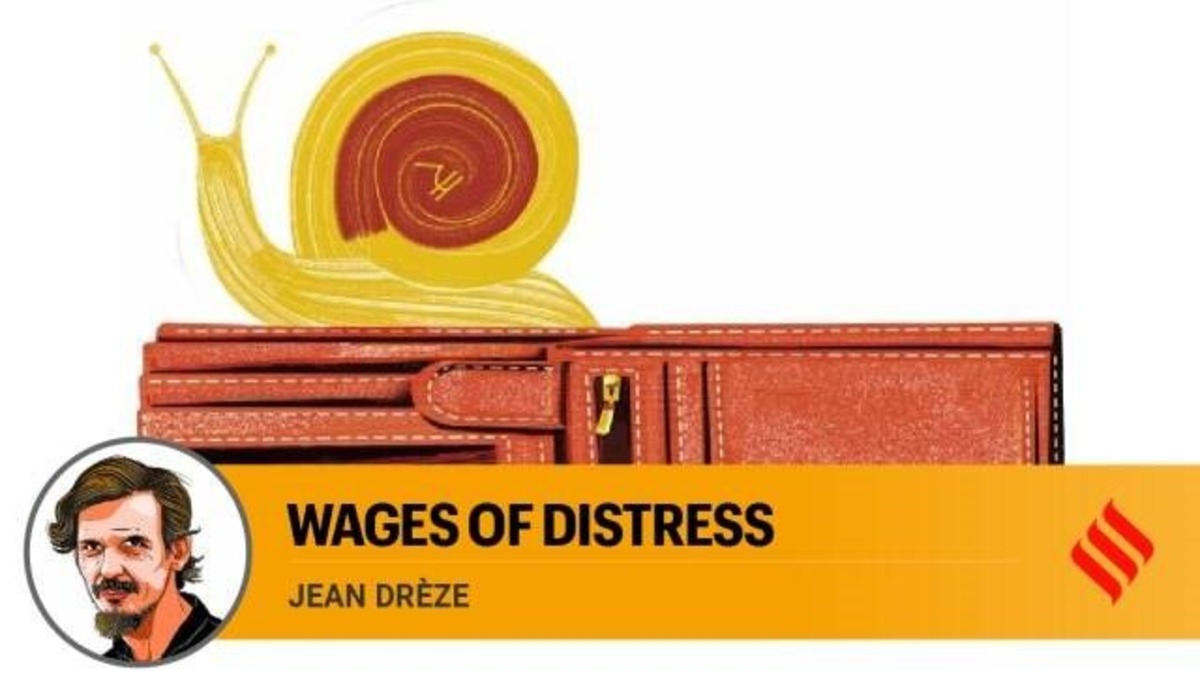Jean Dreze writes: If real wages are rising, workers are likely to be earning more and living better. A sustained rise in real wages is a good sign that economic growth is translating into better jobs. (Illustration by C R Sasikumar)
Jean Dreze writes: There has been no significant growth of real wages at the all-India level or in the last eight years. It calls for a reorientation of economic policies, with more focus on the drivers of wage growth
Written by Jean Dreze
Updated: April 13, 2023 09:09 IST
India’s most important economic indicator is also the most neglected — the growth of real wages. The Statistical Appendix of the latest Economic Survey, for instance, goes on for well over 200 pages without mentioning wages at all. Nor are wages mentioned anywhere in the Union Finance Minister’s latest Budget speech, or in last year’s speech for that matter.
Even in public debates on economic policy, very little attention tends to be paid to real wages. Instead, there are endless discussions of comparatively useless data on “unemployment”. The unemployment figures are not particularly relevant to poor people. In India, poor people are rarely unemployed, because they cannot afford to do nothing. If they are unable to get a good job, they do their best to survive from fallback activities such as selling eggs on the street or pulling a rickshaw. Most of them are not counted as unemployed in household surveys. Their problem is more “underemployment” than unemployment, but underemployment is not measured in these surveys. Indeed, it is hard to measure.
Real wages, on the other hand, are quite informative. If real wages are rising, workers are likely to be earning more and living better. A sustained rise in real wages is a good sign that economic growth is translating into better jobs. Stagnation of real wages, on the other hand, would be a major concern from the point of view of poverty reduction.
Unlike unemployment, real wages are quite easy to track, for some occupations at least. Consider agricultural labour. In most Indian villages, there is a reasonably well-defined wage for casual agricultural labour at any point of time. No household survey is required to find it out — simple enquiries at the village level will do. If this is done at regular intervals in a good number of randomly-selected areas, we can get a fair picture of what is happening to wage rates. Deflating them with a price index to compute real wages is not difficult either.
The Labour Bureau has been doing something like that for many years. The Bureau collects occupation-wise wage data every month in all Indian states and publishes summary statistics in the Indian Labour Journal. The quality of this information is uncertain, but it is likely to be good enough for the purpose of assessing broad trends in real wages.
That task has been made easier by the Reserve Bank of India (RBI). In its latest Handbook of Statistics on Indian States, the RBI presents annual wage estimates based on Labour Bureau data from 2014-15 to 2021-22. Oddly, the estimates pertain to male workers only. They cover four occupation groups: General agricultural labourers, construction workers, non-agricultural labourers and horticulture workers. The last group is ignored here as the wages of horticulture workers are reported for a few states only.
It takes little effort to convert the nominal wage figures into real wages using the Consumer Price Index for Agricultural Labourers (CPIAL) and then to estimate the growth of real wages by semi-log regression of real wages on time. The results are startling. The growth rate of real wages between 2014-15 and 2021-22 was below 1 per cent per year across the board; more precisely 0.9 per cent, 0.2 per cent and 0.3 per cent for agricultural labour, construction workers and non-agricultural labour respectively. If we use the general Consumer Price Index as a deflator, instead of the CPIAL, the growth rates are lower — even negative for construction workers.
The RBI series stops in 2021-22, but more recent figures from the same source presented in the latest Economic Survey clearly show that the pattern of stagnation continued until the end of 2022, when the wage series also ends as of now. The conclusion is clear: There has been no significant growth of real wages at the all-India level in the last eight years. Earlier work by Shambhu Ghatak came to a similar conclusion.
The picture is similar at the state level, for the same period. Consider real wages for agricultural labourers, the fastest-growing series. For this occupation group, the annual growth rate of real wages is above 2 per cent in just two major states: Karnataka (2.4 per cent) and Andhra Pradesh (2.7 per cent). In five major states (Haryana, Kerala, Punjab, Rajasthan, Tamil Nadu), real wages declined between 2014-15 and 2021-22.
A few salutary lessons emerge from this simple exercise. First, we must pay much more attention to real wages. Second, the collection of wage data is begging to be expanded and improved. Third, there is a stark and disturbing contrast today between the rapid growth of the Indian economy and the sluggish growth of real wages.
Finally, this contrast calls for a reorientation of economic policies, with more focus on the drivers of wage growth. If the next Budget speech includes a few words on employment and wages, that will be a good start.
The writer is Visiting Professor at the Department of Economics, Ranchi University
© The Indian Express (P) Ltd
